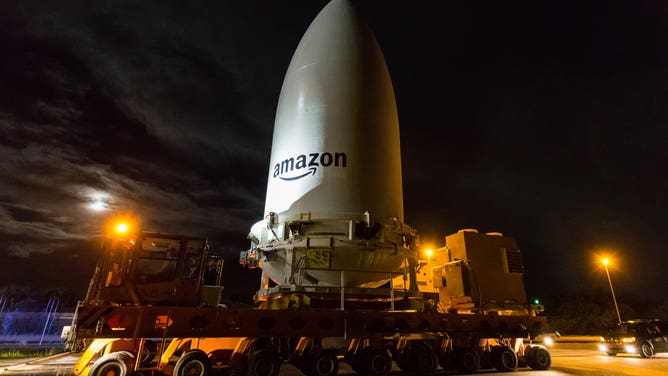ULA launches first test batch of Amazon's Project Kuiper internet satellites
On Friday, two prototype satellites, KuiperSat-1 and KuiperSat-2, launched on a United Launch Alliance Atlas V rocket from Cape Canaveral Space Force Station Launch Complex-41 shortly after 2 p.m. ET.

The Atlas V rocket fairings with the Amazon Project Kuiper satellites in Cape Canaveral, Florida. (Image: ULA)
CAPE CANAVERAL, Fla. – Amazon launched the first two satellites into orbit as part of its space-based internet known as Project Kuiper this week from Florida.
Like SpaceX's Starlink internet, Project Kuiper will beam internet to nearly anywhere in the world using thousands of satellites orbiting Earth.
On Friday, two prototype satellites, KuiperSat-1 and KuiperSat-2, launched on a United Launch Alliance Atlas V rocket from Cape Canaveral Space Force Station Launch Complex-41 shortly after 2 p.m. ET.
Once in orbit, Amazon plans to test the Project Kuiper network end-to-end.
"We’ve done extensive testing here in our lab and have a high degree of confidence in our satellite design, but there’s no substitute for on-orbit testing," Project Kuiper’s vice president of technology Rajeev Badyal said in a statement. "This is Amazon’s first time putting satellites into space, and we’re going to learn an incredible amount regardless of how the mission unfolds."
There is a growing concern from the astronomy community, with thousands of satellites bogging up the night sky.
After the test mission, Amazon said both satellites will be deorbited, burning up in Earth's atmosphere. Amazon said this deorbit plan is part of its "commitment to space safety."
What is Project Kuiper?
Currently, in the test phase, known as Protoflight, Amazon plans to deliver fast, affordable internet worldwide, including places without reliable internet.
There are differences between Project Kuiper and its competitor, SpaceX's Starlink internet.
SpaceX currently has more than 4,000 Starlink satellites in low-Earth orbit, with Starlink launches happening monthly. Eventually, the Starlink constellation will have tens of thousands of spacecraft orbiting the planet. Once complete, the Project Kuiper constellation will have more than 3,200 spacecraft.
STARLINK SATELLITES 'UNINTENDED' ELECTROMAGNETIC RADIATION COULD IMPACT RADIO ASTRONOMY OBSERVATIONS
Amazon plans to actively deorbit satellites within a year of their mission ending.

A rendering of the small Kuiper user terminal. (Image: Amazon)
(Amazon)
The Kuiper System includes satellites in orbit, customer terminals resembling small square satellite dishes and ground-based communications networks, including Amazon Web Services.
Amazon will sell 11-inch square customer terminals that deliver speeds of 400 megabits per second (Mbps). The company expects to produce these terminals for less than $400 apiece. Project Kuiper will also offer smaller 7-inch terminals for personal use and larger 19-inch terminals for businesses, government and companies that require more bandwidth.
Amazon's satellite production facility in Kirkland, Washington, will begin mass-producing Kuiper satellites by the end of the year. After the first operational launches, internet service for customers could start in late 2024, according to Amazon.
Over the next six years, the Project Kuiper constellation will launch with ULA, Blue Origin and Arianespace. Jeff Bezos' Blue Origin is nearing the first launch of its reusable New Glenn rocket from Cape Canaveral and has been contracted by Amazon for 12 Project Kuiper launches.